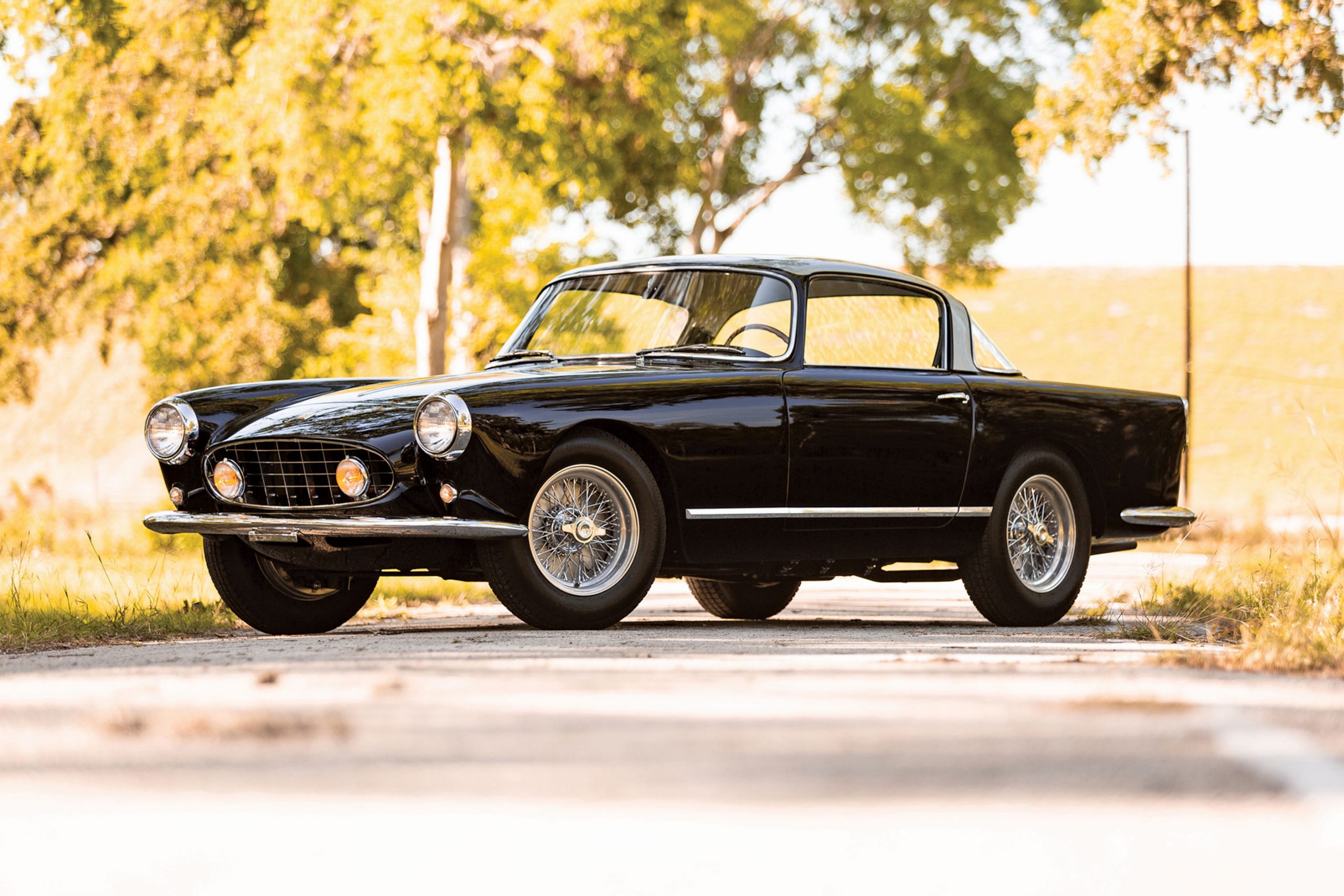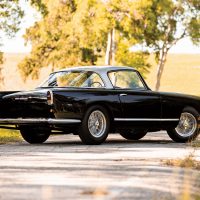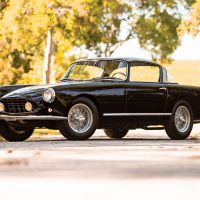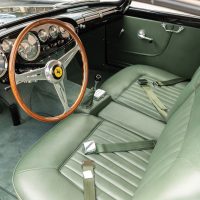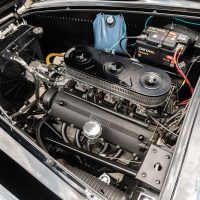SCM Analysis
Detailing
| Vehicle: | 1958 Ferrari 250 GT Coupe by Ellena |
| Years Produced: | 1956–58 |
| Number Produced: | 130 (40 by Ellena, 90 by Boano) |
| Original List Price: | $10,500 |
| SCM Valuation: | $802,500 |
| Tune Up Cost: | $3,000 |
| Distributor Caps: | $450 |
| Chassis Number Location: | On frame tube next to engine |
| Engine Number Location: | On a boss at the right rear of engine |
| Club Info: | Ferrari Club of America |
| Website: | http://www.ferrariclubofamerica.org |
| Alternatives: | 1956 Alfa Romeo 1900 3-window coupe, 1955 Arnolt-Bristol Mark II coupe, 1954 Cisitalia 202 coupe, 2011 Ferrari 599 GTO |
| Investment Grade: | B |
This car, Lot 168, sold for $671,000, including buyer’s premium, during RM Sotheby’s Online Only: Driving into Summer Auction on May 29, 2020.
Both Ellena and Boano carrozzerias built similar 250 GT coupe models. One company is known for building theirs with a low roof and the other company is known for building a high-roof model. Which company built the high-roof version?
From Boano to Ellena
Felice Mario Boano was one of the most influential designers in the Italian coachbuilding business, yet he is most famous for his association with a minor Ferrari model that he didn’t even design: the 250 GT coupe.
Following World War I, Giovanni Farina gave Felice Boano a job at his coachbuilding firm, Stabilimenti Industriali Farina. Boano gained experience turning designs into fabrication, a skill that defined his entire career. Boano left Giovanni to become chief designer at the company owned by Giovanni’s younger brother, Battista “Pinin” Farina. That company would become Italian design powerhouse Pininfarina.
During this time, Boano developed a strong bond with Giacinto Ghia. Carrozzeria Ghia was one of the most famous Italian automobile design and coachbuilding firms. Ghia’s factory was nearly destroyed during World War II. On his deathbed, Ghia instructed his wife to contact Boano to save his company. Boano and his partner, Giorgio Alberti, purchased the company and presided over its revival.
Boano formed an alliance with Chrysler to help fund Ghia. Together they designed several models under the Ghia name. These cars are best remembered for their low-roofline designs.
After losing a bluff to a temperamental designer, Boano reluctantly sold Ghia to that same designer. That signaled the start of Carrozzeria Boano, a firm Boano founded with his son, Gian Paolo.
Pinin Farina’s design
During the early 1950s, Ferrari was building several models. They offered different engine options and bodies from an assortment of coachbuilders. A decision was made that Ferrari needed to standardize production and build a series of similar cars.
The Ferrari 250 GT coupe was the first designated model. The new model would be built in series production using similar bodies and a 3-liter V12 engine.
Pinin Farina was assigned the styling of the 250 GT coupe, and they didn’t waste a lot of time on the project. They had previously designed and built a 3-window coupe body that Ferrari was using on some of their 375 America and 250 Europa chassis. The design was adaptable for series production and was accepted for the 250 GT project.
Ferrari needed to sublet the body construction to an outside firm.
Pinin Farina built a few prototypes, but they were in the middle of an ambitious expansion plan. Construction at their new factory prevented the actual production of the new car. Pinin Farina contracted Boano to build the bodies, and these cars became known as the 250 Boano to differentiate them from other Ferrari 250 GT models.
A one-off Fiat that Boano built for Gianni Agnelli would lead to an offer to put Boano and his son in leadership positions at Fiat’s new Centro Stile department. Boano jumped at the position and sold the coachworks to his son-in-law Ezio Ellena. Carrozzeria Boano became Carrozzeria Ellena, and the construction of Ferrari’s 250 GT coupe continued uninterrupted.
A nice, bland Ferrari
Ellena made some subtle changes to the model, such as eliminating the vent windows and slightly raising the roof. The Ellena-built 250 GT coupes became known as 250 Ellenas or high-roof Boanos.
In an era of flamboyant offerings from Vignale, Ghia, and some of the other Italian designers, the Pinin Farina-designed 250 GT coupe might be called elegant, graceful, tasteful or attractive, but that’s just a kind way of saying the design is bland.
The heart of any Ferrari is its engine, and that’s where the 250 GT coupe doesn’t disappoint. While the America and Europa models featured powerful-but-complicated Lampredi long-block V12s, the 250 GT coupe got a 220-hp version of Ferrari’s Colombo-designed V12. The 250 GT engine is legendary for its power and smoothness.
In the Boano, the engine lives up to its billing. The car’s top speed was just short of 150 mph, dwarfing nearly every other car in production at the time.
Our subject Ellena coupe
Even a somber design from Pinin Farina can tower over the best design from a lesser coachbuilder, and our subject 250 GT “Ellena” coupe proves the point. A silver roof highlights an elegant black body. Inside, green leather with complementing carpet adds an unexpected pop to what could have been a drab space. The excellent mix of colors makes this one of the more interesting 250 GT coupes I’ve seen.
There was a time that 250 GT coupes looked like they were solidly in the million-dollar club, but that’s no longer the case. A Boano last made the mark in 2018, and an Ellena just missed it later that year.
Between those sales, an Ellena seller passed on a $625,000 bid. In early 2019, a Boano seller passed on a million-dollar bid and later that year another Boano seller accepted a $522,000 bid. Our subject Ellena failed to sell for $560,000 last August.
The erratic pricing of 250 GT coupes is in part due to the different quality of the offerings, but that’s not an issue here. There’s nothing I see about 0861GT that would make it a second-string car. The provenance is good, the restoration is good and the mechanical condition is good.
There was no COVID-19 fire sale here. RM Sotheby’s estimate was right on the money. The pre-sale estimate was $625,000 to $725,000, and the bid split the difference.
The seller got a fair market value and the buyer gets to play with the big boys for a value price. Everyone goes home happy. ♦
